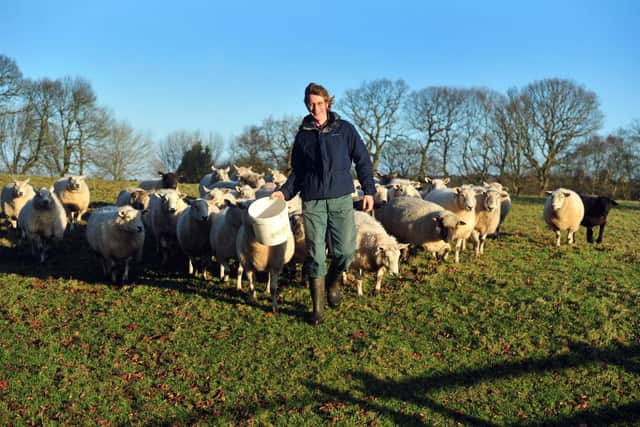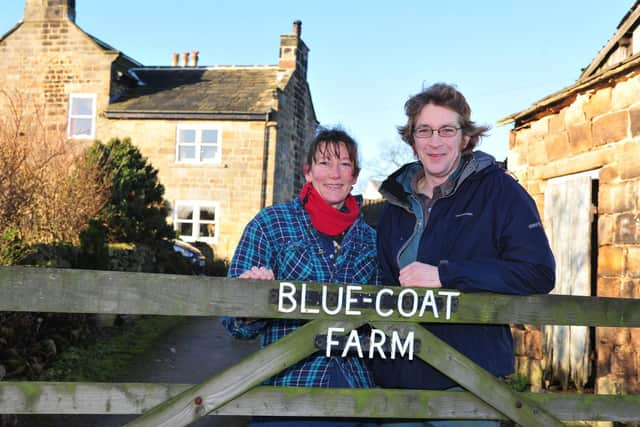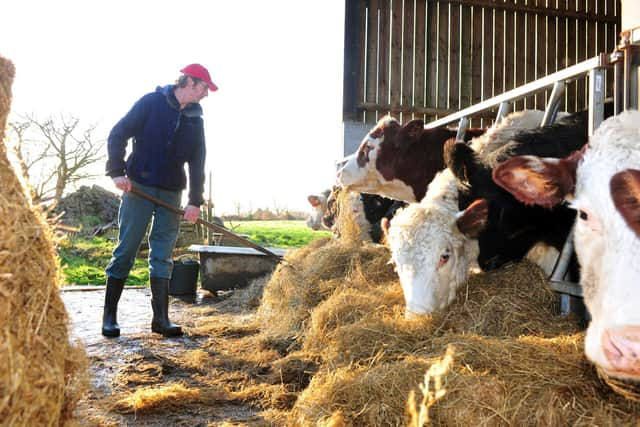Farm of the Week: Improving hedgerow health and rejuvenating wildflower meadows in North Yorkshire
Rob Ruddock farms with his partner Jo Olner at Blue Coat Farm just half a mile out of Harrogate and has always been aware of farming in an environmentally friendly manner, but said he wouldn’t have chosen for walkers - using one of the public footpaths across the farm, many for the first time - to have witnessed something that could have been misconstrued.
“Our hedgerows had needed coppicing, putting back into order. We had ended up with everything having grown so big. Branches were hanging everywhere and the hedges were quite gappy at the bottom.
Advertisement
Hide AdAdvertisement
Hide Ad“The new trees had arrived on the first day of the first lockdown. We were one of the last deliveries for a while and it meant we couldn’t bring any help from outside sources in order to plant them. We all set to the task, myself, Jo, Jo’s brother Jonathan and his wife Alison and my sisters Joanne and Katharine.


“We hadn’t envisaged there would be so many people suddenly on the public footpaths. We have two across the farm. It was amazing. There were huge numbers and we thought there might be a bit of a backlash when people saw us ripping out hedgerows.
“But chatting to people and telling them that we were renewing hedgerows, filling gaps and planting 3,700 trees, we found there was a genuine interest and enthusiasm for our work.
“We explained about the wildlife habitat that hedges provide, wildlife corridors alongside hedges and it was the first time that I realised how the public were happier with taxpayers’ money being used in this way, through countryside stewardship schemes, rather than perhaps a production grant.”
Advertisement
Hide AdAdvertisement
Hide AdRob studied agriculture and environmental management in the 90s and after a globetrotting period in his early 20s, taking in voluntary work in Uganda, working as a field guide in South Africa and touring Australia, he returned to the small family farm in 2002. Jo had returned to the farm next door where she had grown up at around the same time having studied graphic design in London.


Today Rob farms across the 35 acres of Blue Coat Farm and 22 acres of Beckwith Cottage Farm, the latter being jointly owned between Jo and her brother Jonathan.
Rob said he had always had an interest in wildlife and countryside stewardship and that he and Jo share the same passion for zero carbon and regenerative farming.
“Stewardship schemes were just getting going when I came back to the farm and I considered entering into a scheme but it didn’t really fit at the time because of the numbers of cattle I wanted.


Advertisement
Hide AdAdvertisement
Hide Ad“My grandfather had Hereford cattle here and dad had continued with them. I had taken over when I came back and we now have a herd of crossed cattle of predominantly Herefords and Aberdeen Angus. It’s currently around 40-head and we sell as boxed beef.
“The way grazing was mentioned in the earlier stewardship schemes was too prescriptive, but the rules have relaxed a bit and we are now part of the Mid-Tier stewardship scheme.”
Rob has gone into mob grazing, which he said is not because of being in stewardship but fits with his move towards regenerative and sustainable farming.
“I’d come across mob grazing through farmers Joel Salatin in the United States and Allan Savory in Zimbabwe. They put their cattle on to one small area of their land, keeping them there just a day. They muck, munch, trample and are then moved on to the next small area every day.
Advertisement
Hide AdAdvertisement
Hide Ad“It’s all about the rest period. You might only graze that one tract of land a few times a year. We have found this means the roots go down even further, as the grass has time to grow and it makes it come back even stronger, plus it’s great for the cattle.
“The root structure is now massively improved and locks away the carbon. It’s holding the soil together far better too.”
Jo said the benefits to the wildlife are shown every day when the electric fence is moved for the cows to leave one part of the field to go to another. “When we move the fence there is a big cloud of insects and often butterflies that come out of the grass. It’s an amazing sight.”
Rob said the cattle are benefiting too. “It’s a new, fresh source of grass for them everyday and we move them at midday when the sugars are as high as they can be with the sun out.
Advertisement
Hide AdAdvertisement
Hide Ad“As a result of the better sugars and better grasses they’re doing really well, which you can see in their shinier coats. Before we moved to mob grazing we always seemed to struggle for good grass and it never seemed to recover properly. There are also a lot more wildflowers in it.”
Rob and Jo now have nine acres that is designated as species-rich grassland. Rob said it has made another major impact on the farm.
“I’d known what we’d had for a long time but I needed it properly designated as such with Defra and when the professional biologists came to conduct a species survey they were blown away and told us we had all of the key indicator species, around 50 wildflowers including everything from field scabious to dog violets, meadow buttercups and several species of orchid.”
Rob also takes hay off the species-rich grassland and is now talking with the National Wildflower Centre about improving other meadows. He said he’s happy with his involvement in the Mid Tier Stewardship scheme.
Advertisement
Hide AdAdvertisement
Hide Ad“It is creating another income stream for the farm. We normally also have sheep, which we will bring back this year. I was a little hesitant about taking public monies for what we are now doing but I’ve been encouraged by the response we’ve had from walkers and we are looking to go a bit above and beyond to create a habitat everyone can enjoy.”
